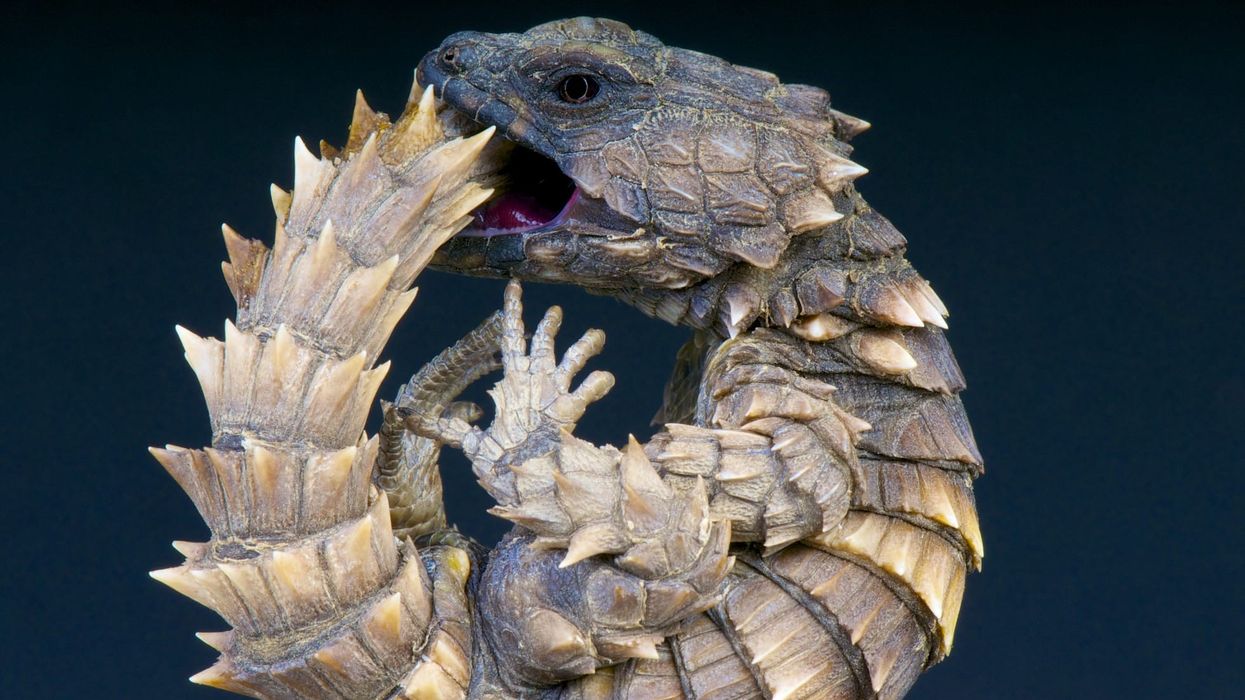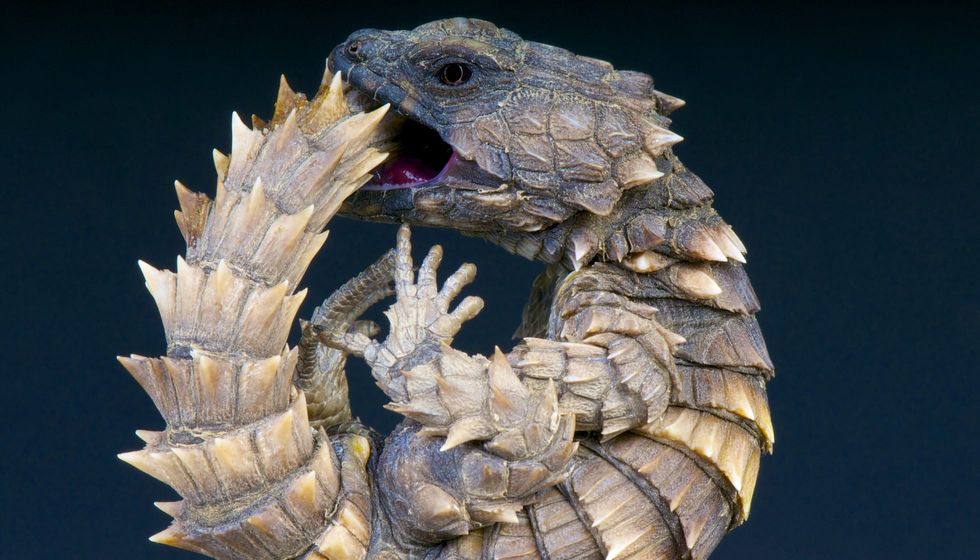Fun Armadillo Lizard Facts For Kids

The armadillo lizard, also called the armadillo girdled lizard, armadillo spiny-tailed lizard, or the Golden-armadillo lizard, is among the lizards belonging to the class of reptiles within the Cordylidae family. The scientific name of this lizard species is Ouroborus cataphractus, although they were previously called Cordylus cataphractus.
These lizards live in rock crevices in mountain slopes and rock outcrops along the western coast of South Africa. The distribution of these lizards is desert regions along the west coast of South Africa.
They inhabit the Succulent Karoo biome in the North and Western Cape provinces in South Africa. The distribution range of this lizard species includes southern Richtersveld to Piketberg Mountains and southern Tankwa Karoo.
The armadillo girdled lizard has armor-like spiny scales covering the neck, tail, body, and limbs. They are light brown to dark brown in color and usually have a soft, vulnerable underside that is yellow, with a blackish pattern under the chin.
The lizard tail is usually the same length or slightly shorter than the length of the body. The flat head and tail of these lizards make it possible for them to squeeze into rock crevices easily.
Read on for more interesting facts about the armadillo lizard. For more animal facts, check out our articles on monitor lizard facts and garden lizard facts.
Armadillo Lizard Interesting Facts
What type of animal is an armadillo lizard?
The armadillo lizard or armadillo girdled lizard is among the species of lizards within the Cordylidae family and Ouroborus genus. The scientific name of this lizard species is Ouroborus cataphractus.
What class of animal does an armadillo lizard belong to?
The armadillo lizard, also called the armadillo girdled lizard, armadillo spiny-tailed lizard, or the Golden-armadillo lizard, is among the lizards belonging to the class of Reptilia, within the Cordylidae family.
How many armadillo lizards are there in the world?
There is currently no accurate estimate of the population of armadillo lizards to add to armadillo girdled lizard facts, however, the IUCN Red List does give this reptile species the conservation status of Least Concern.
Where does an armadillo lizard live?
Armadillo lizard's habitat consists of rock crevices in mountain slopes and rock outcrops along the western coast of South Africa. The distribution of these lizards is desert regions along the west coast of South Africa.
They inhabit the Succulent Karoo biome in the North and Western Cape provinces in South Africa. The distribution range of this lizard species includes southern Richtersveld to Piketberg Mountains and southern Tankwa Karoo.
What is an armadillo lizard's habitat?
Armadillo lizard's, Ouroborus cataphractus, habitat consists of rock crevices in mountain slopes and rock outcrops, specifically sandstone substrates along the western coast of South Africa. The regions they inhabit typically have sparse vegetation, where dwarf perennial shrubs dominate.
Who do armadillo lizards live with?
Armadillo lizards in the wild live in social groups with 30 to 60 lizards. The reptile males are territorial and protect their territory fiercely while mating with females in the group.
How long does an armadillo lizard live?
Armadillo lizards raised in captivity as opposed to the wild can live for 20 - 25 years. Their natural lifespan in the wild is not yet known.
How do they reproduce?
While males are protective of their territory, they aren't protective of their mates and females often cross territorial bounds for mating with other males.
Mating happens once a year in spring, with the mating season being September to October. Females usually give birth to one or two young lizards in March or April.
Reproduction in the species is ovoviviparous. Fertilization is internal and females do not lay eggs. Usually, there will be an adult pair of males and females, a sub-adult, and young offspring that are 2.5 in (6.35 cm) long at birth.
Females do not lay eggs but give birth after a gestation period of six to eight months. They usually attain sexual maturity at 3.7 in (9.3 cm) of length. Once females give birth, they may also provide food for their young, something that is unusual for lizards. Females sometimes take a year off between births.
What is their conservation status?
Until 1996, the armadillo girdled lizard was classified as Vulnerable by the IUCN due to the exotic pet trade. The capturing of these lizards from the wild and keeping them as pets has since been made illegal.
The armadillo girdled lizard is currently given the conservation status of Least Concern as per the IUCN Red List. There are, however, several factors that threaten the population of this species.
They are still threatened by the illegal exotic animal pet trade. Climate change has disrupted rainfall patterns which affect their primary source of food, termites. Poor fire management and the introduction of alien plant species in their natural habitat also threaten their survival.
Armadillo Lizard Fun Facts
What do armadillo lizards look like?
The armadillo girdled lizard has armor-like spiny scales covering the neck, tail, body, and limbs. They are light brown to dark brown in color and usually have a soft, vulnerable underside that is yellow, with a blackish pattern under the chin.
The lizard tail is usually the same length or slightly shorter than the length of the body. The flat head and tail of these lizards make it possible for them to squeeze into rock crevices easily. They have dark brown upper lips.
How cute are they?
If you're inclined to find lizards cute, you're sure to find the armadillo girdled lizard cute, especially the young lizards. The cuteness of these animals has made them popular pets today.
How do they communicate?
Armadillo lizards have many ways of communicating with each other. Head bobbing, tongue flicking and tail wagging are some methods of communication used by these animals. These are useful for reproduction and to warn other lizards from outside the social group to leave.
How big is an armadillo lizard?
The average length of lizard armadillo, Ouroborus cataphractus, is 3-3.5 in (7.6-8.89 cm). Armadillo lizards can, however, grow to a length of 8 in (20.3 cm) which is the snout-to-vent length.
How fast can an armadillo lizard move?
These animals are sluggish and slow-moving, which is what enables many to pick them up from the wild and sell them illegally. Living in social groups aids their quick escape. They also tend to stay close to rock crevices in the wild so that they can escape quickly.
How much does an armadillo lizard weigh?
The armadillo girdled lizard, Ouroborus cataphractus, typically weighs between 2.5-3.5 oz (70.8-99.2 g).
What are the male and female names of the species?
Males and females of this species are not known by different names. They are referred to as armadillo lizards only.
What would you call a baby armadillo lizard?
A baby armadillo lizard is called a young or juvenile armadillo lizard.
What do they eat?
These lizards mainly eat insects, especially termites (Hodotermes and Microhodotermes), beetles, millipedes, spiders, and scorpions in the wild as part of their diet. When kept as a pet, instead of termites, these lizards eat crickets as their main diet.
Are they poisonous?
Armadillo lizards are not poisonous and can even be kept as pets, but they do have a strong bite that you need to watch out for.
Would they make a good pet?
Armadillo lizards make good pets, especially for beginners because they have a docile nature and an even temperament. Keeping at least two together is recommended as these animals normally live in social groups in the wild.
It is important that you understand the needs of these reptiles (diet, habitat) before deciding to keep them as pets though. This way, you will be able to provide them with an environment suitable for their growth and be able to identify any signs of distress or ill health if they arise.
Did you know...
In Latinized Greek, the word 'oura' represents tail and 'boros' means devouring. Thus, ouroborus represents a symbol of a dragon or snake swallowing its tail, a fitting name for armadillo lizards due to their protective adaptation in which they turn into a ball with their tail in their jaw.
This species of lizard can sometimes break their own jaw while chewing on their food due to their strong bite.
Armadillo lizards are prone to mouth infections that can be identified if there is pus around the mouth. They also suffer from femoral pore infections, characterized by swelling of the rear legs. The hardy nature of the species makes them likely to recover quickly from such infections.
The armadillo lizard's adaptation
The armadillo girdled lizard has a unique adaptation to protect itself from predators. When threatened, armadillo lizards curl up into an armored ball, gripping their tail in their jaw. The spiny scales on the body of these lizards protect them from predators who find it difficult to catch and swallow them due to the scales.
This curled-up position protects their vulnerable underparts from predators. They also have powerful jaws that can cause severe damage with one bite. They usually bite when threatened.
In extreme danger from predators or otherwise, armadillo lizards can drop their tail and grow it back slowly later. This interferes with their defensive position though so it is only adopted as a last resort by these lizards.
Keeping armadillo lizards
While capturing them from the wild and keeping them as pets is illegal, you can purchase a captive-bred lizard armadillo from a private breeder. An armadillo lizard pet can cost you $1,000-$2,000.
You can expect to factor in another $200 for a 30 gal (136.3 l) tank and $20 for an under-tank heater. For their diet, you will need to provide crickets as their food, which will cost you $2 for packs of 50.
You should set up their tank before bringing one home. Ideal temperature and humidity requirements are 80-85 F (26.6-29.4 C) (daytime temperature), 115-130 F (46.1-54.4 C) (basking spot), and 45% – 55% humidity.
Some armadillo lizard pet facts you need to be aware of are that these are typically inactive animals. They're going to spend most of their time in their basking spot or hiding between crevices, so don't expect the activity level you would from other animals kept as pets.
You should also avoid handling them as much as possible because they tend to get stressed when handled. Never hold them aggressively as it could remind them of a bird of prey and make them defensive.
You can get a reptile carpet as a substrate for your lizard. Make sure you keep the lighting on for 12 hours a day for these diurnal creatures so that their natural circadian rhythm develops.
Here at Kidadl, we have carefully created lots of interesting family-friendly animal facts for everyone to discover! For more relatable content, check out these sand lizard facts and Gila monster facts for kids.
You can even occupy yourself at home by coloring in one of our free printable armadillo lizard coloring pages.
We Want Your Photos!
More for You
Bachelor of Arts specializing in Linguistics

Martha MartinsBachelor of Arts specializing in Linguistics
Martha is a full-time creative writer, content strategist, and aspiring screenwriter who communicates complex thoughts and ideas effectively. She has completed her Bachelor's in Linguistics from Nasarawa State University. As an enthusiast of public relations and communication, Martha is well-prepared to substantially impact your organization as your next content writer and strategist. Her dedication to her craft and commitment to delivering high-quality work enables her to create compelling content that resonates with audiences.
Postgraduate Diploma in Management

Sakshi RaturiPostgraduate Diploma in Management
Sakshi has experience in marketing strategy, social media planning, and recruiting industry experts for capstone projects, she has displayed a commitment to enhancing their skills and knowledge. She has won multiple awards, including a Certificate of Appreciation for Creative Writing and a Certificate of Merit for Immaculate Turut, and is always seeking new opportunities to grow and develop.
Disclaimer
1) Kidadl is independent and to make our service free to you the reader we are supported by advertising. We hope you love our recommendations for products and services! What we suggest is selected independently by the Kidadl team. If you purchase using the Buy Now button we may earn a small commission. This does not influence our choices. Prices are correct and items are available at the time the article was published but we cannot guarantee that on the time of reading. Please note that Kidadl is a participant in the Amazon Services LLC Associates Program, an affiliate advertising program designed to provide a means for sites to earn advertising fees by advertising and linking to Amazon. We also link to other websites, but are not responsible for their content.
2) At Kidadl, we strive to recommend the very best activities and events. We will always aim to give you accurate information at the date of publication - however, information does change, so it’s important you do your own research, double-check and make the decision that is right for your family. We recognise that not all activities and ideas are appropriate for all children and families or in all circumstances. Our recommended activities are based on age but these are a guide. We recommend that these ideas are used as inspiration, that ideas are undertaken with appropriate adult supervision, and that each adult uses their own discretion and knowledge of their children to consider the safety and suitability. Kidadl cannot accept liability for the execution of these ideas, and parental supervision is advised at all times, as safety is paramount. Anyone using the information provided by Kidadl does so at their own risk and we can not accept liability if things go wrong.
3) Because we are an educational resource, we have quotes and facts about a range of historical and modern figures. We do not endorse the actions of or rhetoric of all the people included in these collections, but we think they are important for growing minds to learn about under the guidance of parents or guardians.







